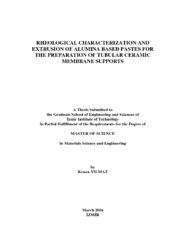Please use this identifier to cite or link to this item:
https://hdl.handle.net/11147/4833Full metadata record
| DC Field | Value | Language |
|---|---|---|
| dc.contributor.advisor | Çiftçioğlu, Muhsin | en_US |
| dc.contributor.author | Yılmaz, Kenan | - |
| dc.date.accessioned | 2017-02-14T07:06:10Z | |
| dc.date.available | 2017-02-14T07:06:10Z | |
| dc.date.issued | 2016-03 | |
| dc.identifier.citation | Yılmaz, K. (2016). Rheological characterization and extrusion of alumina based pastes for the preparation of tubular ceramic membrane supports. Unpublished master's thesis, İzmir Institute of Technology, İzmir, Turkey | en_US |
| dc.identifier.uri | http://hdl.handle.net/11147/4833 | |
| dc.description | Thesis (Master)--Izmir Institute of Technology, Material Science and Engineering, Izmir, 2016 | en_US |
| dc.description | Full text release delayed at author's request until 2019.03.07 | en_US |
| dc.description | Includes bibliographical references (leaves: 83-85) | en_US |
| dc.description | Text in English; Abstract: Turkish and English | en_US |
| dc.description | xii, 96 leaves | en_US |
| dc.description.abstract | Membrane applications in the industry currentlyis dominated by polymeric membranes, however, in recent years the development of ceramic membranes gained significant attention because of their superior chemical/thermal stability and corrosion resistance. The separation capacities of ceramic membranes basically depend on the nature of the selective oxide layers formed on the inner surfaces of tubular ceramic supports. Ceramic tubular membrane supports were prepared from alumina pastes, with solid loadings as high as 55 vol. % and water was used as the major liquid phase. Boehmite along with hydroxypropyl cellulose ethers with different molecular weightswere used as binder materials. Glycerol was used as a lubricant in the paste formulations. Extrusion of alumina paste was conductedwith a ram extruder using capillary dies with a series of L/D ratios at different extrusion velocities and the data was analyzed by using Benbow and Bridgwater model. The rheological properties of various pastes were determined according to the 4 and 6-parameter models.The six parameter model was concluded to better represent the experimental data. The viscosities of the paste batches were also determined by using the model parameters o, 1, and exponent n. The pastes were determined to have a shear thinning behaviour Piston extruder was used for shaping of tubular ceramic supports and the pressure varied in the 20-90 bar range with paste composition and rheology. The tubular extruded supports were dried, debinded to burn out organic binders and sintered at 1525ºC for the formation of about 40% porous mechanically strong membrane supports. | en_US |
| dc.description.abstract | Membranlar biyokimyasal ayırma süreçleri, tekstil, kağıt ve metal endüstrisi gibi farklı endüstrilerde saflaştırma ve ayrıştırma işlemleri için kullanılmaktadır. Seramik membranlar genel olarak seçici oksit katmanlarının tübüler seramik destekler üzerine konulmasıyla oluşturulur. Katı madde oranları yüzde 55 seviyesine kadar olan ve ana ortam sıvısı su olacak şekilde hazırlanan alumina hamurlarından, seramik tübüler membranlar hazırlanmıştır. Bağlayıcı malzeme olarak böhmit ile birlikte farklı molekül ağırlıklarınıa sahip hidroksi selülöz eterler kullanılmıştır. Hamur hazırlanışında gliserin yağlayıcı olarak kullanılmıştır. Ön çalışmalar için orifice tipi kalıpta ram extrüzyon kullanılmış ve veriler mekanik mukavemet test cihazıyla alınmıştır. Alümina hamur ekstrüzyonu farklı L/D oranlarına sahip kapileri kalıplar kullanılarak farklı ekstrüzyon hızlarında ram ekstrüderi ile gerçekleştirilmiş ve alınan veriler aynı test cihazıyla Benbow Bridgwater modeli kullanılarak analiz edilmiştir. Çeşitli hamurların reolojik özellikleri 4 ve 6 parametreli modellere bağlı olarak belirlenmiştir. 6 parametreli modelin alumina hamurlarıyla daha yakın ekstrüztyon grafiklerine sahip olduğu belirlenmiştir. Hazırlanan seramik hamurlarının viskoziteleri model parametreleri o, 1, ve n kullanılarak hesaplanmıştır. Tübüler seramik hamurlarının şekillendirilmesi piston ekstrüder kullanılarak yapılmış ve hamurunun reolejisi ve kompozisyonuna bağlı olarak piston ekstrüder basıncı 20-90 bar arasında değişiklik göstermiştir. Ekstrüde edilmiş tübüler destekler kurutulup organik bağlayıcılarından arındırılmış ve %40 poroziteye sahip mekanik olarak güçlü membran destekleri elde etmek amacıyla 1525ºC’de ısıl işlem uygulanmıştır. | en_US |
| dc.description.sponsorship | The Scientific and Technological Research Council of Turkey (TUBITAK) ÇAYDAG 113Y344 project | en_US |
| dc.language.iso | en | en_US |
| dc.publisher | Izmir Institute of Technology | |
| dc.publisher | Izmir Institute of Technology | en_US |
| dc.relation | info:eu-repo/grantAgreement/TUBITAK/CAYDAG/113Y344 | en_US |
| dc.rights | info:eu-repo/semantics/embargoedAccess | en_US |
| dc.subject | Rheology | en_US |
| dc.subject | Rheological properties | en_US |
| dc.subject | Membrane technologies | en_US |
| dc.subject | Alumina membranes | en_US |
| dc.subject | Ceramic tubular membrane | en_US |
| dc.title | Rheological characterization and extrusion of alumina based pastes for the preparation of tubular ceramic membrane supports | en_US |
| dc.title.alternative | Tubular seramik membran desteklerinin hazırlanmasına yönelik alümina bazlı hamurların reolojik karekterizasyonu ve ekstrüzyonu | en_US |
| dc.type | Master Thesis | en_US |
| dc.institutionauthor | Yılmaz, Kenan | - |
| dc.department | Thesis (Master)--İzmir Institute of Technology, Materials Science and Engineering | en_US |
| dc.request.email | kenan1169@hotmail.com | |
| dc.request.fullname | Kenan Yılmaz | |
| dc.relation.publicationcategory | Tez | en_US |
| item.languageiso639-1 | en | - |
| item.fulltext | With Fulltext | - |
| item.openairecristype | http://purl.org/coar/resource_type/c_18cf | - |
| item.openairetype | Master Thesis | - |
| item.grantfulltext | open | - |
| item.cerifentitytype | Publications | - |
| Appears in Collections: | Master Degree / Yüksek Lisans Tezleri | |
Files in This Item:
| File | Description | Size | Format | |
|---|---|---|---|---|
| T001499.pdf | MasterThesis | 4.11 MB | Adobe PDF |  View/Open |
CORE Recommender
Page view(s)
234
checked on Jul 22, 2024
Download(s)
1,012
checked on Jul 22, 2024
Google ScholarTM
Check
Items in GCRIS Repository are protected by copyright, with all rights reserved, unless otherwise indicated.